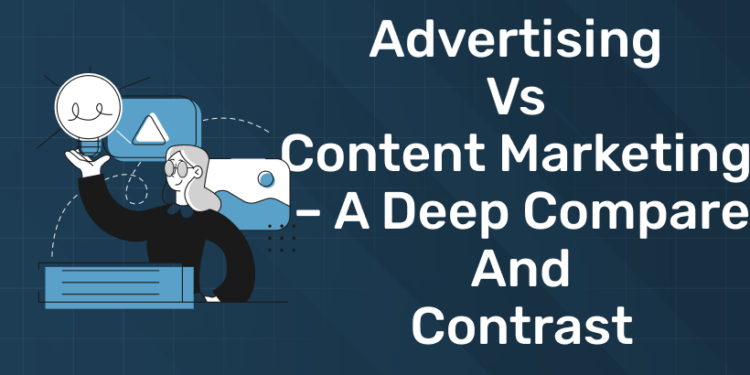Table of Contents
Both advertising and content marketing are methods via which business/companies introduce their products and services to its consumers. In short they help in connecting the businesses with their customers. Although they share the same purpose the method; the media via which they are done are different. In this article we will discuss Advertising Vs Content Marketing – A Deep Compare And Contrast.
Unlock the Power of Digital Marketing! Join Our Free Trial Course Today.
Advertising Vs Content Marketing – A Deep Compare And Contrast
What is Advertising?
Advertising:
- Is a paid promotion of products or services.
- Creates brand awareness and drives sales.
- Utilizes various channels like TV, digital, print.
- Emphasizes product features and benefits.
- Targets specific audience demographics or interests.
Types of Advertising:
Print Advertising: Advertisements placed in newspapers, magazines, posters, and brochures.
Broadcast Advertising: Advertisements played on TV and radio commercials.
Digital Advertising: Advertisement on websites, search engines, social media, and apps.
Outdoor Advertising: Advertisements displayed on Billboards, transit ads, and signage.
Direct Mail Advertising: Flyers, catalogs, and postcards printed to be distributed.
Social Media Advertising: Advertisements played or displayed on platforms like Facebook, Instagram, and Twitter.
Mobile Advertising: Ads played on mobile devices such as smartphones and tablets.
Native Advertising: Sponsored content that blends with the publication’s format.
Product Placement: Showing products in TV shows, movies, or video games.
Influencer Marketing: Collaborating with influencers to promote products or services.
Advantages of advertising:
Wide Reach: Advertising helps reach larger audience.
Brand Visibility: It increases the visibility of the business.
Targeted Messaging: Helps in targeting the correct audience.
Immediate Impact: Can give immediate result. Sales can boost suddenly.
Controlled Placement: we can control when and where the ad should appear.
Creative Freedom: creative expression and storytelling is allowed.
Measurable Results: Offers metrics for tracking performance and ROI.
Brand Positioning: Helps establish the brand in the market .
Product Promotion: Facilitates direct promotion of products and services.
Synergy: Works with other marketing efforts to reinforce messaging.
Limitations of advertising:
Cost: Advertising can be expensive, especially for TV or radio.
Short-Term Impact: Results may be short-lived.
Ad Avoidance: Many consumers actively avoid or ignore ads.
Cluttered Environment: Ad saturation can make it difficult to stand out among the competition.
Limited Targeting: Some advertising channels offer limited targeting options, causing inefficient spending.
Ad Fatigue: Overexposure to ads can lead to audience fatigue and decrease the effectiveness.
Intrusiveness: Intrusiveness may lead to negative perceptions of the brand.
Measurement Challenges: measuring the effectiveness of advertising can be complex.
Message Control: Once ads are out, there is no control over how it will be shared or interpreted.
Creative Restrictions: Adherence to advertising standards may limit creativity.
What is content Marketing?
1: What is the primary goal of SEO (Search Engine Optimization)?
Content Marketing:
- Provides valuable content to attract and engage audience.
- Builds trust and credibility with informative, relevant content.
- Utilizes various formats like blogs, videos, infographics.
- Focuses on storytelling and audience needs.
- Drives long-term customer relationships and loyalty.
Types of content Marketing:
Blogs and Articles: Informative and engaging written content on various topics.
Videos: Videos shared on platforms like YouTube.
Infographics: Visual representations of information.
Podcasts: Audio content covering specific topics.
Ebooks and Whitepapers: In-depth reports on relevant subjects.
Social Media Posts: Contents shared on platforms like Facebook, Instagram, and LinkedIn.
Case Studies: case studies on successful projects or customer experiences.
Webinars: Live or recorded online seminars on industry-related topics.
Email Newsletters: Regular updates or insights sent to subscribers’ to their e-mail IDs.
Interactive Content: Quizzes, assessments, or interactive tools for the audience.
Advantages of content marketing:
Builds Trust: Providing valuable content establishes trust with the audience.
Increases Brand Awareness: Consistent content exposure helps in bringing brand awareness.
Boosts Engagement: Engaging content helps in interactions and shares, attracting a loyal audience.
Improves SEO: Good content improves search engine visibility and rankings.
Drives Traffic: good content attracts visitors to your website or social media channels.
Nurtures Leads: content marketing also helps you in getting leads.
Cost-Effective: Compared to traditional advertising, content marketing is more cost-effective.
Demonstrates Expertise: Sharing industry knowledge positions your brand as an authority in your field.
Long-Term Results: some content continues to generate leads and traffic over a long time.
Adaptable and Versatile: same content can be re-used across different platforms and formats.
Limitations of content marketing:
Time-Intensive: Creating good content takes time and needs resources.
Results Take Time: It me take time for content marketing techniques to show results.
Content Saturation: standing out can be challenging as the internet is filled with lot of contents.
Measuring ROI: measuring the direct impact of content marketing on sales can be difficult.
Continuous Effort: Content creation and distribution needs continuous work and consistency.
Skill and Expertise: one must be expert in writing, design, and marketing to produce good content.
Algorithm Changes: content visibility depends on changes in search engine algorithms or social media algorithms.
Competitive Landscape: The competition is tough as there will be many other brands trying to gain the attention the audience.
Content Decay: Content need to be replaced time to time as it may get irrelevant with time.
Limited Reach: Content marketing may not reach as wide an audience as paid advertising methods.
Unlock the Power of Digital Marketing! Join Our Free Trial Course Today.
Become an AI-powered Digital Marketing Expert
Master AI-Driven Digital Marketing: Learn Core Skills and Tools to Lead the Industry!
Explore CourseAdvertising Vs Content Marketing
| Aspect | Advertising | Content Marketing |
| Objective | Drive immediate sales, create brand awareness | Attract and retain audience, build trust |
| Content Type | Short, persuasive messages (e.g., ads) | Varied content formats (e.g., blogs, videos) |
| Audience Engagement | Interrupts audience, may be intrusive | Provides value, fosters deeper engagement |
| Cost and Distribution | Requires budget for media placement | Can be cost-effective, relies on organic channels |
| Brand Messaging | Direct, emphasizes product features | Storytelling, subtle brand mention |
| Timing and Results | Immediate impact, short-term outcomes | Long-term brand loyalty, sustained engagement |
| Measurement | Metrics like impressions, clicks, conversions | Metrics like engagement, shares, time on page |
| Control | Full control over message and placement | Less control over distribution, relies on audience interaction |
| Relationship Building | Transactional approach | Focuses on building relationships and trust |
| Flexibility | Less flexible due to paid placements | More flexibility to experiment with content |
| Audience Reach | Wide reach through paid placements | Targeted reach based on audience interests |
The businesses can choose between content marketing and advertising depending on their business goals, target audience, budget, and resources. Both have their strengths and can complement each other in reaching their audience.
Conclusion
Advertising and Content management are two different approaches taken by businesses to reach their audiences. Advertising is to reach a larger audience and involves higher costs. Content management mainly focuses on trust building and is cost-effective. Businesses can use both based on their goals, target audience, and budget.
Entri’s Digital Marketing Course
Entri Elevate’s Digital Marketing course is a focused training program to improve your digital marketing skills. Learn basic marketing concepts and how to apply them practically. The course is taught in Malayalam for easier understanding. Gain hands-on experience with industry tools and procedures. Get help finding a job within a year after completing the course.
Advertising Vs Content Marketing – A Deep Compare And Contrast: FAQs?
1. What is advertising?
Ans. Advertising:
- Is a paid promotion of products or services.
- Creates brand awareness and drives sales.
- Utilizes various channels like TV, digital, print.
- Emphasizes product features and benefits.
- Targets specific audience demographics or interests.
2. What are the types of advertising?
Ans: Types of advertising are:
- Print Advertising
- Broadcast Advertising
- Digital Advertising
- Outdoor Advertising
- Direct Mail Advertising
- Social Media Advertising
- Mobile Advertising:
3. What is content marketing?
Ans. Content Marketing:
- Provides valuable content to attract and engage audience.
- Builds trust and credibility with informative, relevant content.
- Utilizes various formats like blogs, videos, infographics.
- Focuses on storytelling and audience needs.
- Drives long-term customer relationships and loyalty.
4. What are the types of content marketing?
Ans. Types of content Marketing:
- Blogs and Articles
- Videos
- Infographics
- Podcasts
- Ebooks and Whitepapers
- Social Media Posts
- Case Studies
- Webinars
- Email Newsletters
- Interactive Content
5. What to choose content marketing or advertising?
Ans. Advertising is to reach a larger audience and involves higher costs. Content management mainly focuses on trust building and is cost-effective. Businesses can use both based on their goals, target audience, and budget.
Unlock the Power of Digital Marketing! Join Our Free Trial Course Today.












